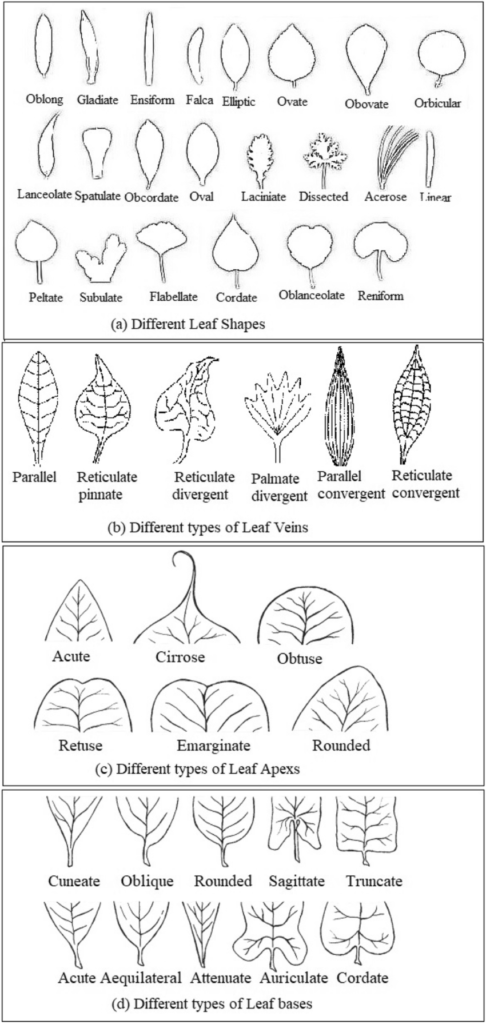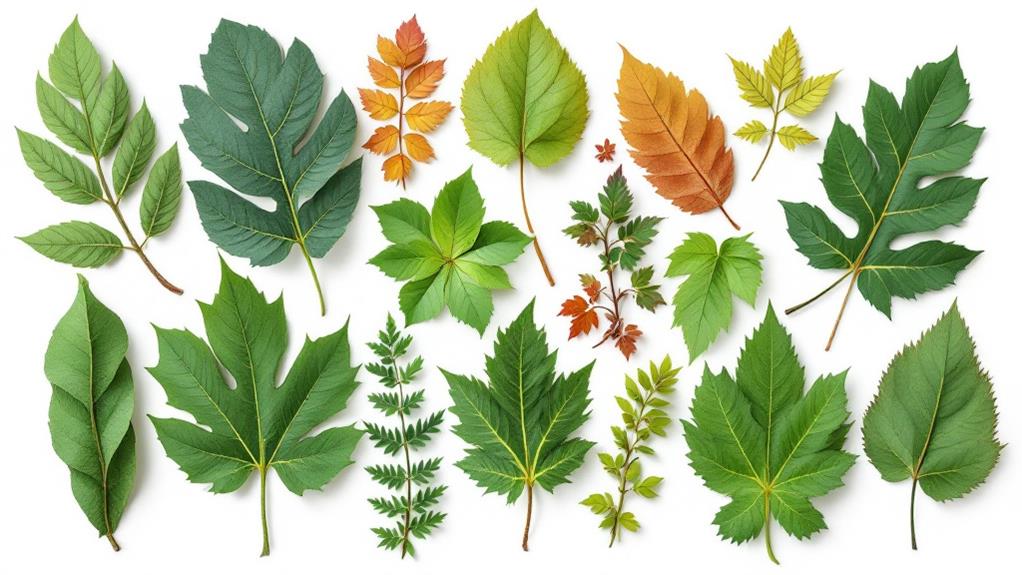Leaf morphology types encompass a wide variety of shapes, arrangements, and structures. You’ll find simple leaf shapes like ovate, lanceolate, and cordate, as well as compound arrangements such as palmate and pinnate. Venation patterns, including pinnate and parallel, play a significant role in leaf function. Leaf edges can be smooth, toothed, or lobed, while surfaces may be glossy or covered in tiny hairs. These characteristics reflect adaptations to different environments, from arid deserts to lush rainforests. Understanding leaf morphology is essential for plant identification, ecological studies, and insights into plant evolution. Exploring these diverse leaf features can reveal a world of botanical knowledge.

Simple Leaf Shapes

Simple leaf shapes can be broadly categorized into several distinct types, each with its own unique characteristics. One of the most basic forms is the simple ovate leaf, which resembles a rounded, egg-shaped structure. This shape is common among many broad-leaved plants, offering an efficient surface area for photosynthesis.
Another prevalent simple leaf shape is the lanceolate, which is long and narrow, tapering to a point at the tip. This streamlined design is often seen in grasses and certain trees, providing a high surface-to-volume ratio that can be advantageous in environments with limited resources.
The cordate leaf, with its distinctive heart-shaped silhouette, is another common simple form. This shape is frequently observed in deciduous trees and herbaceous plants, often serving as a visual cue for plant identification.
Lastly, the simple leaf can also take on a linear or strap-like appearance, with parallel sides and an elongated, ribbon-like structure. This shape is common in monocots, such as lilies and grasses, and can be an adaptation for efficient light capture and water transport.
Regardless of the specific type, simple leaf shapes play a significant role in the overall function and appearance of a plant, contributing to its adaptability and survival in diverse environments.
Compound Leaf Arrangements
In addition to simple leaf shapes, plants can also exhibit more complex compound leaf arrangements. These arrangements feature leaves that are divided into multiple smaller, individual leaflets attached to a central axis. The number, arrangement, and shape of these leaflets can vary greatly across different plant species.
One common type of compound leaf is the palmate arrangement, where multiple leaflets radiate outward from a single point on the central axis, resembling the fingers of an open hand. Another type is the pinnate arrangement, in which the leaflets are positioned along opposite sides of the central axis, creating a feather-like appearance. Some plants even have bipinnate or tripinnate leaves, where the leaflets themselves are further divided into smaller sub-leaflets.
The specific compound leaf arrangement of a plant can provide valuable clues about its taxonomic classification and evolutionary relationships. For instance, the palmate leaves of the maple tree are a distinguishing feature of the Acer genus. Likewise, the pinnately compound leaves of the rose family, or Rosaceae, are a unifying characteristic among its members. Understanding the diversity of compound leaf morphologies is an important aspect of plant identification and ecology.
Venation Patterns
Another key aspect of leaf morphology is the venation patterns visible within the leaf blade. These patterns refer to the arrangement and distribution of the veins that transport water and nutrients throughout the leaf. There are several distinct venation patterns that you can observe in different plant species.
The most common venation pattern is the pinnate arrangement, where a central midrib runs the length of the leaf, and secondary veins branch off from it at regular intervals, resembling a feather. This pattern is seen in plants like oak, elm, and walnut. In contrast, the palmate venation has several main veins radiating outward from the leaf’s base, as found in plants like maple and grape.
Other less common venation patterns include the parallel arrangement, with veins running parallel to each other, as seen in grasses and lilies, and the reticulate pattern, which features a net-like web of interconnected veins, as observed in plants like most dicots. The venation can also be classified as either open, where the veins terminate before reaching the leaf margin, or closed, where the veins form a continuous loop.
Recognizing the diverse venation patterns is an essential skill in leaf identification and can provide valuable insights into a plant’s evolutionary adaptations and ecological relationships.
Leaf Edge Structures
The leaf edge, or margin, exhibits a variety of structures that contribute to a plant’s overall appearance and function. These structures can be smooth, toothed, lobed, or even spiny, and they play a significant role in the plant’s defense mechanisms and interaction with its environment.
Smooth leaf edges are the most basic type, with a continuous, uninterrupted outline. This simple structure is common in many plants and is often associated with a more delicate or refined appearance. Toothed leaf edges, on the other hand, feature small projections or serrations along the margin, which can provide improved water drainage and protection against herbivores.
Lobed leaf edges are characterized by deeper indentations or divisions, creating a more complex and distinctive shape. These structures can enhance a plant’s surface area, aiding in photosynthesis and gas exchange. Spiny leaf edges, though less common, are adapted for defense, deterring potential predators and herbivores from damaging the plant.
The specific edge structures found on leaves are often closely linked to a plant’s evolutionary adaptations and environmental conditions. Understanding these variations in leaf edge morphology can provide insights into the plant’s ecology, growth strategies, and interactions with its surroundings.
Leaf Surface Characteristics

Beyond the leaf edge, the surface characteristics of a leaf can vary considerably across different plant species. The surface may be smooth and glossy, or it could be covered in tiny hairs, known as trichomes. These trichomes can be found on the upper, lower, or both surfaces of the leaf, and they can serve various functions, such as reducing water loss, deterring herbivores, or even trapping dust and debris.
Another surface feature to examine is the presence of cuticular waxes. These waxy coatings can make the leaf surface appear slightly shiny or glaucous, and they help prevent excessive water loss. The density and composition of these waxes can vary, influencing the leaf’s water-repellent properties and even its ability to self-clean.
The surface texture of a leaf can also be described as smooth, rugose (wrinkled), or even pitted. These characteristics are often related to the leaf’s age, as older leaves may become more textured over time. Additionally, some leaves may have a papillate surface, with tiny, raised protrusions that can enhance light absorption or create a water-repellent effect.
Ultimately, the diverse range of leaf surface characteristics reflects the adaptations of plants to their environment and the various challenges they face, from water conservation to herbivore defense.
Leaf Adaptations to Environment
As plants have adapted to a diverse range of environments, their leaves have evolved specialized features to cope with the unique challenges they face. You’ll find that these adaptations help plants survive and thrive in various conditions, from arid deserts to tropical rainforests.
In dry environments, you’ll notice leaves with adaptations to conserve water. They’re often small, thick, and waxy, reducing surface area and water loss through transpiration. Some desert plants have leaves that fold or curl during hot periods, further minimizing exposure. Succulent plants store water in their thick, fleshy leaves, allowing them to survive long periods without rain.
For plants in high-light environments, you’ll see leaves with light-reflecting surfaces or vertical orientations to reduce sun exposure. Conversely, plants in low-light conditions often have large, thin leaves to maximize light capture for photosynthesis.
In aquatic environments, you’ll find leaves with different adaptations. Floating leaves are often large and flat, with stomata on the upper surface. Submerged leaves may be finely divided to increase surface area for gas exchange and reduce drag in moving water.
Plants in cold climates have leaves adapted to withstand freezing temperatures. You’ll notice some with small, needle-like leaves that resist frost damage and reduce water loss in cold, dry air.
Wind-resistant adaptations are common in coastal or mountainous areas. You’ll see leaves with strong petioles, lobed shapes, or compound structures that flex easily in strong winds, reducing the risk of damage or uprooting.
Evolutionary Significance of Leaf Morphology

Throughout evolutionary history, leaf morphology has played a significant role in plant survival and adaptation. You’ll find that different leaf shapes and structures have evolved to help plants thrive in various environmental conditions. For instance, plants in arid regions often develop small, thick leaves to reduce water loss, while those in tropical rainforests may have large, thin leaves to maximize light capture.
The evolutionary significance of leaf morphology extends beyond simple adaptation. It’s a key factor in plant speciation and diversification. As plants colonize new habitats, their leaves often undergo rapid evolutionary changes to better suit their new environments. This process can lead to the development of unique leaf characteristics that distinguish one species from another.
You’ll notice that leaf morphology also influences plant-animal interactions. The shape, size, and texture of leaves can affect herbivory rates, with some leaf types offering better protection against predators. Additionally, leaf morphology can impact pollination and seed dispersal strategies, further driving evolutionary change.
Climate change has put a spotlight on the importance of leaf morphology in plant adaptation. You’ll see that plants with more flexible leaf morphologies may be better equipped to survive in rapidly changing environments. This adaptability could be essential for species survival in the face of global warming and shifting precipitation patterns.
Understanding the evolutionary significance of leaf morphology isn’t just academic; it has practical applications in agriculture and conservation. By studying how leaf shapes have evolved, you can gain insights into developing more resilient crops and preserving biodiversity in a changing world.
Practical Applications of Leaf Morphology
Delving into practical applications, leaf morphology offers valuable insights across various fields. You’ll find that botanists and ecologists use leaf characteristics to identify plant species, assess ecosystem health, and study plant adaptations to different environments. By examining leaf shape, size, and venation patterns, you can determine a plant’s taxonomy and understand its evolutionary history.
In agriculture, leaf morphology plays an essential role in crop breeding and management. You can use leaf traits to select for desirable characteristics like drought resistance or increased photosynthetic efficiency. Farmers and agronomists often rely on leaf morphology to diagnose nutrient deficiencies or pest infestations, allowing for timely interventions.
Forensic scientists utilize leaf morphology in criminal investigations. You can analyze leaf fragments found at crime scenes to link suspects to specific locations or determine the time of year an event occurred. This information can be vital in solving cases and providing evidence in court.
In the field of paleobotany, you’ll find that leaf morphology helps reconstruct ancient ecosystems and climates. By studying fossilized leaves, you can infer past environmental conditions and track changes in plant communities over geological time scales.
Landscape architects and urban planners consider leaf morphology when designing green spaces. You can select plants with specific leaf characteristics to create visually appealing environments, manage stormwater runoff, or improve air quality in cities.

Erzsebet Frey (Eli Frey) is an ecologist and online entrepreneur with a Master of Science in Ecology from the University of Belgrade. Originally from Serbia, she has lived in Sri Lanka since 2017. Eli has worked internationally in countries like Oman, Brazil, Germany, and Sri Lanka. In 2018, she expanded into SEO and blogging, completing courses from UC Davis and Edinburgh. Eli has founded multiple websites focused on biology, ecology, environmental science, sustainable and simple living, and outdoor activities. She enjoys creating nature and simple living videos on YouTube and participates in speleology, diving, and hiking.

